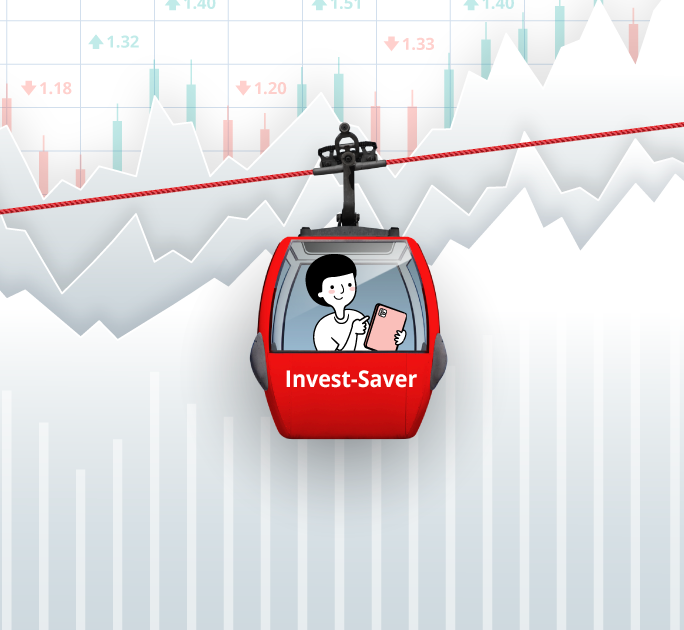Options to consider other than T-bills
By Navin Sregantan
![]()
If you’ve only got a minute:
- T-bills will likely remain attractive, but yields are coming off their peaks, which means investors should consider alternatives.
- Options to consider for income include short duration and high-quality bonds, high dividend stocks and short-term endowment plans.
- Remember to do your due diligence before deciding which investment options are best suited to you.
![]()
Combating inflation is a key focus of major central banks. To manage persistent inflation in 2023 and 2024, central banks like the US Federal Reserve, made monetary policy moves to raise interest rates. This meant that for the first time in a decade, investors were able to find meaningful opportunities in high quality fixed income investments.
In Singapore, Treasury bills (T-bills) - Singapore government debt securities that mature typically in 6 months or 1 year - received strong interest as investors were being compensated with higher yields while taking less or zero risk than a couple of years before.
To put things into context, at the time of issue, a June 2020 6-month T-bill had a yield of 0.2% per annum (p.a.). This contrasted with an April 2024 6-month T-bill, which at issue, provided a yield of more than 3.7% p.a..
That said, the tide is turning. With inflation in the US easing towards the 2% target, the rate of hiring slowing, and the US unemployment rate increasing, the Fed has already strongly indicated that it is looking to cut rates in late 2024 and 2025.
In fact, the conversation has already shifted from whether rates will be cut, to how many rate cuts are on the horizon.
At the time of writing, markets are anticipating up to 4 rate cuts by January 2025, with more expected for the rest of next year. DBS economists are expecting a cut of 25 basis points each in September and December 2024.
With T-bills issued last year and earlier in 2024 recently maturing or nearing maturity, these investors will be facing a reinvestment risk as rates fall. It begs the question:
“What are the next steps for investors to consider?”
Even though T-bills will probably remain attractive compared to 3 to 4 years ago, yields are coming off their peaks, which means investors should consider a range of alternatives.

What are the alternatives to T-bills?
Bearing in mind that we are at the end of the hiking cycle, the next move for interest rates is more likely to be down than up.
In such a scenario where we are on the verge of a rate cutting cycle, it is often short-term yields that fall the fastest and largest after the first cut.
What this means is that investors face the highest reinvestment risk at the turn of the policy cycle if they are reinvesting into fixed income investments like T-bills and short-term fixed deposits.
As such, investors can consider other income-generating investments on top of T-bills.
Some examples include:
- Short duration, high quality bonds
- High dividend stocks
- Short-term endowment plans
Short duration, high-quality bonds
After the aggressive rates hikes of the past 2 years, markets are expecting lower rates in 2024 and 2025.
DBS Chief Investment Office (DBS CIO) is of the view that investors can consider locking in higher yields in short-duration, high quality fixed income instruments like investment grade (IG) corporate bonds. This means investing in bonds with a credit rating of at least BBB with a duration of 1 to 3 years to capitalise on the turn of the rate hiking cycle.
Historically, the average yield on IG corporate bonds is around 3.2% p.a.. With elevated interest rates, these bonds have become attractive again. As of end-July 2024, they have an average yield of 4.9% p.a., which offers an opportunity for investors seeking higher potential returns than fixed deposits or T-bills.
Given that short-end rates (i.e. fixed income with maturities of ≤ 1 year) are the most impacted once cuts ensue, bonds with a duration of 1 to 3 years stand to gain with more certainty from a repricing of the rate environment.
Corporate bonds usually require a minimum investment of S$250,000, leaving many retail investors priced out. Instead, this group of investors can consider investing in a basket of high-quality bonds through robo-advisors like DBS digiPortfolio and pooled investment products like unit trusts or exchange-traded funds (ETFs).
Read more: 8 things to know before buying bonds
SaveUp digiPortfolio
DBS digiPortfolio’s SaveUp portfolio, provides a low-risk and high-quality exposure to the fixed income market.
As of end-August 2024, the Save-Up portfolio was generating a yield of 5.0% p.a. with an IG credit quality and a portfolio duration of 2 years.
The portfolio’s yield is significantly higher than its long-term projected range of 1.5 to 2.5% p.a..
At current yields, the portfolio is well-positioned to deliver better returns than fixed deposits or Singapore T-bills over the longer term, assuming no unforeseen adverse events.
Save-Up does not have a lock-in period, which means it can be useful for investors to park funds while waiting for market opportunities.
What’s more, SaveUp not only has the lowest management fee among DBS digiPortfolios at 0.25% p.a., but the lowest minimum amount for lump-sum investment of S$100.
Read more: How to start investing with a robo-advisor
Find out more about: DBS digiPortfolio
CIO Liquid+ Fund
DBS CIO’s Liquid+ Strategy is an investment approach that focuses on investing in government and IG bonds with an average duration of the portfolio being between 1 and 3 years.
Investors can also consider investing in the DBS CIO Liquid+ Fund (minimum investment of S$1,000), provided their risk tolerance allows for it. This fund is available for retail investors and is an expression of DBS CIO’s Liquid+ Strategy.
The DBS CIO Liquid+ Fund is available for retail investors and is an expression of DBS CIO’s Liquid+ Strategy. Moreover, investors can consider this fund as part of the income half of the DBS CIO Barbell Strategy.
Read more: What is the Barbell Strategy?
Find out more about: Investing in unit trusts with DBS

High dividend stocks & trusts
One of the most accessible ways to earn passive income is through investing in dividend stocks.
Dividend stocks that tend to be popular are those of mature companies with stable revenue, profits and cashflow. Many of these companies are known as Blue-Chips.
While not exactly dividend stocks, real estate investment trusts (Reits) are also a popular choice for dividend hunters as they are required to distribute 90% of income earned to unitholders.
For dividend investors, such stocks and Reits can be found at relatively reasonable prices during periods of high yields for fixed income instruments.
These long-term investors typically take advantage of depressed stock and unit prices during periods of higher fixed income yields to position for a period of lower interest rates in the future.
Investors who prefer exposure to equity markets with the option of receiving regular income, can consider DBS digiPortfolio’s Income Portfolio (minimum investment of S$1,000).
The Income Portfolio gives you access to income-generating equities as well as fixed income securities, in a readymade solution.
It also distributes regular income. As of end-August 2024, the portfolio’s distribution yield stands at 4.4% p.a., contributed by a mixed-asset portfolio of income equities, high quality government and corporate bonds.
Read more: Tips to pick quality dividend stocks
Find out more about: DBS digiPortfolio
Short-term endowment plans
A short-term endowment policy –a hybrid of both life insurance and savings components – is another way to grow your wealth.
Such hybrid plans are commonly used to save money for specific savings goals, like funding children’s education or your retirement. These plans also provide basic life insurance protection for as long as the policy is in force.
While returns tend to be lower relative to equities, these products can provide you with the stability of income.
However, be prepared to commit to your policy as surrendering early may lead to a loss in the premiums paid.
As of late-August 2024, SavvyEndowment - a short-term endowment plan - has a guaranteed yield of 3.0% p.a., provided you hold it till maturity.
Read more: 4 types of insurance plans to boost your retirement income
Find out more about: SavvyEndowment
Sticking with T-bills?
Of course, you can. After all, we have not seen such attractive returns for fixed income investments with an AAA credit rating and issued by the Singapore government in a long while.
At current yields, T-bills still offer investors, especially those who are conservative, a safe investment option with competitive returns. The same applies for fixed deposits.
With impending interest rate cuts on the horizon, if you would like to lock in better long-term rates today, Singapore Savings Bonds (SSBs) might be an option. This is because you can enjoy the flexibility to exit the 10-year tenor investment anytime without any capital loss and penalty.
If you have been investing your CPF Ordinary Account (CPF-OA) savings into T-bills via the CPF Investment Scheme (CPFIS), do take note of the potential risks of investing your CPF balances in T-bills when yields are falling.
You will need to work out the “breakeven” yields of T-bills for using CPF savings so that you will not be in a worse off position than if you had left your CPF-OA monies idle (i.e. collecting 2.5% p.a. of interest).
This isn’t as straightforward as you might think because CPF contributions received this month start earning interest next month and withdrawals/deductions in this month will not earn interest from this month onwards.
Depending on when the deduction is done from your CPF account, you can lose up to 2 months of CPF interest. Assuming you lose 2 months of interest, the recommended minimum cut-off yield for investing in 6-month T-bills using CPF-OA is 3.33%. For 1-year T-bills, it will be 2.92%.
In other words, if the cut-off yields are lower than those mentioned above, you are better off leaving your funds in CPF-OA or investing in other CPF-approved investments that suit your risk tolerance.
Read more: Investing in T-bills
In summary
Over the past 2 years, the higher yields offered by quality fixed income investments like T-bills have been a boon to many. But with yields likely to fall in 2024 and 2025, investors should at least assess if which alternatives to T-bills are suitable for them.
By investing in diversified IG bond funds, you do not need to worry about holding onto the investments until maturity as you can sell them anytime, with relative ease. This contrasts with fixed deposits and endowment plans which are instruments that should be held to maturity.
It goes without saying that investing is an effective way to build and preserve your wealth while minimising the effects of inflation.
However, focusing mainly on low-risk products like T-bills may not be sufficient to mitigate inflation and achieve financial freedom. This is where investing for the long-term via compounding comes in. If you are investing for the long-term (i.e. you have an investment time horizon of at least 10 years), do consider diversifying your investment portfolio and consider some exposure to equities, which have historically generated higher returns in the long run.
At the end of the day, do remember to align your investments to your risk profile, financial goals, and time horizon. And do your due diligence before deciding which options are best suited to you.
Ready to start?
Need help selecting an investment? Try ‘Make Your Money Work Harder’ on digibank to receive specific investment picks based on your objectives, risk profile and preferences.
Invest with DBS Invest with POSB
Speak to the Wealth Planning Manager today for a financial health check and how you can better plan your finances.
Sources:
DBS Treasures, “Asset Allocation 3Q24: Complicated Last Mile”, Accessed 21 August 2024.
DBS Treasures, “Global Credit 3Q24: Tipping Point”, Accessed 21 August 2024.
DBS Treasures, “The Golden Opportunity in Fixed Income”, Accessed 21 August 2024.
DBS, "DBS CIO Liquid+ Fund", Accessed 21 August 2024.
Disclaimers and Important Notice
This article is meant for information only and should not be relied upon as financial advice. Before making any decision to buy, sell or hold any investment or insurance product, you should seek advice from a financial adviser regarding its suitability.
All investments come with risks and you can lose money on your investment. Invest only if you understand and can monitor your investment. Diversify your investments and avoid investing a large portion of your money in a single product issuer.
Disclaimer for Investment and Life Insurance Products








That's great to hear. Anything you'd like to add? (Optional)
We’re sorry to hear that. How can we do better? (Optional)